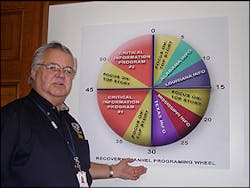Katrina Recovery Reports Produced at the National Fire Academy
Katrina victims who've relocated to other parts of the country can see what's going on in their neighborhoods back home via to the Recovery Channel.
The programs are produced in studios at the National Emergency Training Center on the campus of the National Fire Academy in Emmitsburg.
To get vital information to those who need it, federal officials didn't have to re-invent the wheel. They just had to dust off the cameras and bring the studios back to life.
"This information is critical to making life choices," said Bruce Marshall, project manager. "We're giving the victims what they need to know."
This isn't the first time that the federal government has turned to the airwaves to inform victims after a disaster. The station went on the air after an earthquake in California. "We're delivering straight-forward, unfiltered information," Marshall said.
The program is being aired on Channel 206 on Dish Network and on local government access channels on Cablevision. Outlets throughout the United States are broadcasting the show from 10 a.m. to 8 p.m. EST and 9 -7 CST. "People from the Gulf states have re-located everywhere. That's why it's important we reach them."
A colorful wheel tells viewers when they can expect information and pictures from specific states. Victims can learn where to go to get help for housing, replacement documents such as drivers' licenses and medical needs. Spokespeople from various federal and state agencies explain the process and where to locate a recovery center.
Photographers in the Gulf are sending video back to the studio where it's edited and made part of the program. "They're getting some phenomenal footage, and it's fresh daily," said Jennifer Starobin, executive producer.
Starobin, a former producer at Fox News Channel, said her crew shares her enthusiasm. "We all want to make a difference in people's lives. It's been a challenge for us to take all this information and put it out there on a nationwide level."
Recovery Channel personnel have an open invitation out for agencies providing help to get their information out there. Each segment features one or more interviews.
The staff understands the target audience has had their lives turned upside down. "We repeat things over and over...We know that victims may not be in their right state of mind...We keep the information they need coming."
Each program is recorded the day before it airs, and while that's going on people are working on the next segment. Scripts are written, edited and submitted to the appropriate people for review.
Two former television news anchors, Dianna Gee and Jamilah Fraser, stand in front of the cameras and read from teleprompters as they would on any set. Meanwhile, on a split screen viewers see what's going on in their state, the widespread destruction as well as cleanup operations.
"I was ready for a change," Gee said. "This is perfect. I feel like I'm helping, even in a small way."
The Recover Channel crew recites its theme throughout each broadcast - "Good information for good decisions."
